
|
THE RIVER AND THE ROCKS
The Geologic Story of Great Falls and the Potomac River Gorge |
THE ORIGIN OF THE ROCKS

Waterworn rocks keep silent vigil over the Potomac River
As the Potomac River strips away the soil and cuts into the underlying bedrock, it lays bare a fascinating record of events stretching back in time 500 million years or more. In order to reconstruct this story, we must look beyond the obvious cracks and fractures which control the form of the river gorge, and study the more subtle features of the rocks. A brief search around the Great Falls area reveals five distinct kinds of rock: mica schist, metagraywacke, amphibolite, granite, and lamprophyre (see table below). The mica schists, metagraywackes, and amphibolites are rocks that have been deeply buried within the earth's crust and transformed (metamorphosed) by heat and pressure to their present state. Prior to metamorphism the schists were muds or shales, the metagraywackes were beds of muddy sandstone, and the amphibolites were originally sheets of lava or once-molten rock similar to basalt.

Geologic Time Chart
The rocks at Great Falls
| Name | Description | Color | Original rock |
| Mica schist | Abundant coarse flakes of mica oriented along parallel planes. Thin veinlets of quartz cutting the schist stand out as a delicate network of ribs on weathered outcrops. | Silvery gray; weathers to reddish brown. | Shale or mudstone. |
| Metagraywacke | Fine-grained quartz and some mica. Rock has a sugary texture on weathered outcrops; occurs interstratified with mica schist in layers 3 inches to 3 feet in thickness. | Light bluish gray to buff. | Muddy sandstone. |
| Amphibolite | Black crystals of hornblende in white to pink feldspar; occurs in layers 2 to 100 feet in thickness. | Dark green to black. | Once-molten rock similar to basalt. |
| Granite | Quartz and feldspar with mica; occurs as cross-cutting sheets and irregular masses. | White to pink. | Once-molten rock with high silica content. |
| Lamprophyre | Chiefly mica; occurs as crosscutting sheets. | Dark green. | Once-molten rock with low silica content. |
The shales and muddy sandstones were deposited on the bottom of an ancient ocean, probably in a deep trough near the coast of a rugged landmass. Farther east, near Chain Bridge, the metamorphosed shale and sandstone exposed in the sides of the valley at Great Falls grade into thick deposits of muddy sandstone containing jumbled pebbles and boulders of quartz, amphibolite, granite, and other rocks. These materials were deposited by huge submarine landslides that cascaded down the steep eastern side of the trough. The muddy sandstones at Great Falls were probably formed from thick slurries of mud and sand that moved downslope from the main slides and came to rest in the bottom of the trough. The shales at Great Falls were originally muddy sediments that were carried seaward by ocean currents and settled to the bottom during the quiet intervals between the slides. Soon after deposition of these sediments, molten lava was injected in thick sheets parallel to the layers of sandstone and shale and cooled to form the layers of basaltlike rock that later became amphibolite. The high landmass from which these sediments were eroded has long been obliterated, but it probably lay only a few miles to the east. It was made up largely of granitelike rocks similar to those exposed today near Baltimore which are about 1,100 million years old.
The exact time when the sediments were deposited is uncertain because no fossils have been found in them, but dating of a rare radioactive mineral (zircon) in the amphibolites shows that the amphibolites were intruded about 550 million years ago, and the sediments are probably about the same age.
Since first formed, these rocks have undergone a full and varied history. As younger sediments accumulated above them, they became accordingly more deeply buried. They were later compressed, folded, metamorphosed, and finally intruded by granite. The different stages in this complex sequence of metamorphic events are outlined in the accompanying figure. The total thickness of sediment that accumulated can be inferred from laboratory experiments which show that a mineral (sillimanite) which grew in the schists when the granites were intruded requires a temperature of 1150°F and a pressure of 80,000 pounds per square inch to form; it would require a blanket of sediments about 11 miles thick to produce this pressure. The exact age of this deformation and recrystallization is unknown, but dates on similar granites near Baltimore suggest that the granites at Great Falls were intruded about 425 million years ago, and most of the deformation must have been accomplished by that time.
 |
Sediments are deposited on the sea floor and eventually become layers of mudstone and muddy sandstone. |
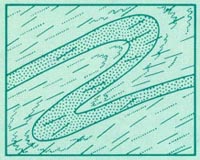 |
The layers of rock are folded and the mudstones recrystallize to form mica schists. The flakes of mica grow in parallel planes to form a new structure—schistosity—which cuts across the original layering. |
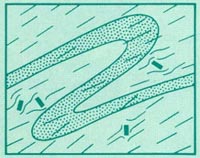 |
The growth of large crystals of kyanite and andalusite push the planes of schistosity aside. |
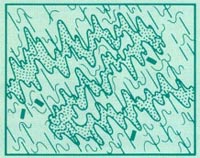 |
The layers are folded again, and new planes of schistosity are formed at angles to the first. |
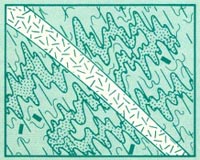 |
Rocks are fractured and molten material wells up along the cracks to form granite intrusions. Kyanite and andalusite are altered to sillimanite. |
| Structural and metamorphic history of crystalline rocks. | |
Thus far in the history of these rocks, events were controlled by forces deep within the earth which led to the down-buckling of the sea floor, accumulation of sediments, and later compression and folding. After the emplacement of the granite, however, a fundamental change took place; the earth's crust stopped moving down, and slowly began to rise again, carrying the Great Falls rocks back toward the earth's surface where we find them today. As the crust rose, overlying rocks were eroded, and the resulting debris was transported westward, where it accumulated as thick sedimentary deposits which now make up the main part of the Appalachian Mountains. Erosion was very rapid during the initial stages of this uplift, suggesting that the Piedmont area at that time was very mountainous, perhaps like the Rocky Mountains today.
As erosion followed uplift, temperatures in the rocks at Great Falls gradually declined, and the rocks became fractured as they cooled. Along some of the fractures, molten rock material of a different type rose and solidified to form the sheets or dikes of lamprophyre. Dating of the minerals in the lamprophyres shows that they were intruded about 360 million years ago. Later, movement occurred along other fractures, called faults. Commonly, the rock along them is shattered and crushed so that it is more easily eroded than the unbroken rocks on either side. The straight narrow section of the gorge below Rocky Islands is cut along one such fault.
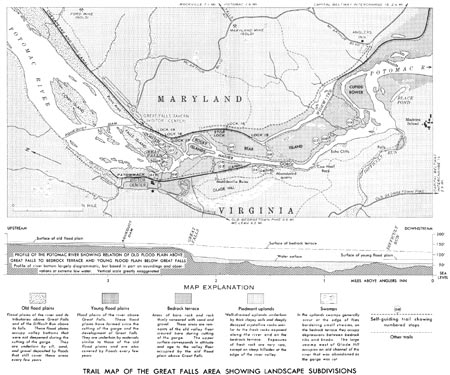
|
| Trail map of the Great Falls area showing landscape subdivisions. (click on image for an enlargement in a new window) |
Along other parallel faults, hot solutions from below deposited thick veins of white quartz. Some of these veins carry small amounts of native gold which was mined sporadically in the area from 1867 until as recently as 1941. Many of these faults and quartz veins have the same orientation as faults of Triassic age (about 200 million years old) a few miles to the west, and the faults at Great Falls may be of the same age.
The Triassic faults appear to have developed in response to a final stage of uplift, a regional arching and stretching of the Piedmont rocks, which produced a series of fault-bounded basins by subsidence of keystone-shaped blocks. These basins were then filled with the red shales and sandstones of Triassic age which crop out a few miles west of Great Falls in the Leesburg Basin and Frederick Valley.
At this stage in the geologic story, we have come full circle; the record of the rocks merges with the origin of the river and the development of its valley. But the chronicle of the river and the rocks is told best not by words and sketches on a printed page, but by the face of the land and by the rocks themselves. To read the story for yourself, you are invited to take one or more of the trails maintained by the National Park Service on either side of the river.

| <<< Previous | <<< Contents >>> | Next >>> |
bul/1471/sec5.htm
Last Updated: 01-Mar-2005